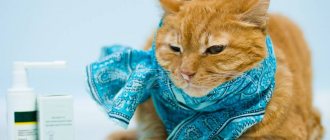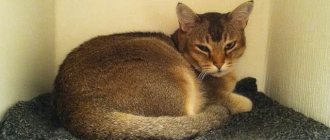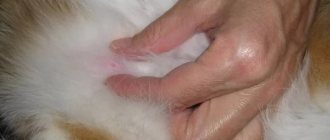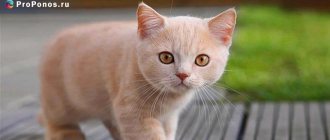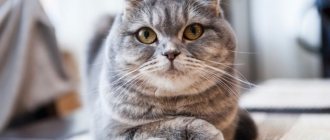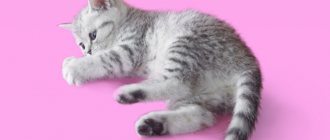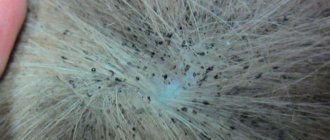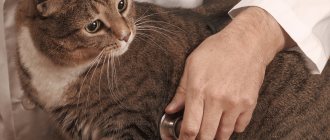Causes
Pus from the nose
Diseases in which pus is discharged from the nose are divided into contagious and non-contagious.
The following are considered contagious:
- Herpes (rinotracheitis);
- Calicivirus;
- Cat flu;
Among the diseases of non-contagious etiology, the following most often develop:
- chronic diseases and colds;
- foreign bodies;
- congenital anomalies;
- tumors.
The causes of diseases, clinical symptoms, methods of diagnosis, treatment and prevention are not the same. Let's consider each disease separately.
Herpes (rhinotracheitis)
Herpes
The disease occurs among unvaccinated cats when kept in crowded conditions, unbalanced feeding in nurseries or shelters. Sick kittens die 10-14 days after the first signs appear. Those who have recovered become a reservoir of infection. There is a high probability of transplacental infection. The owner brings the virus into the apartment.
In addition to nasal discharge and cough, stomatitis, conjunctivitis with subsequent ulceration of the cornea, and mouth breathing develop. Constipation occurs and pregnant women abort. In the chronic course of the disease, panophthalmitis develops and the cat goes blind. An accurate diagnosis is established in the clinic.
The treatment is developed by a veterinarian. Prevention consists of timely vaccination, bringing living conditions and feeding into compliance with standards. If a cat refuses to eat for a long time, it is fed through a nasoesophageal tube. If signs of dehydration are detected, droppers with plasma substitutes are placed.
Nasoesophageal tube
When the cat begins to feed on its own, the veterinarian prescribes wet canned food or soaked granules.
Be sure to read:
A cat's eyes are running: normal or pathological, reasons, what to do, how to treat, prevention
Calicivirus
Ulcerative glossitis with calcivirosis.
In terms of symptoms, etiology, and pathogenesis, the viral disease resembles Herpes. A cough occurs and bronchopneumonia develops.
Distinctive features are ulcerative stomatitis and the absence of ulcerations on the cornea. Lameness appears suddenly, but disappears spontaneously after a few days. The treatment strategy and prevention are the same as for Herpes.
Cat flu
Polyvalent vaccine
Often Herpes and Calicivirus affect a pet at the same time. The disease was called cat flu. When making a diagnosis, attention is paid to the presence of signs of both diseases. A complex vaccine against calicivirus, rhinotracheitis and panleukopenia reliably protects against infection.
Cat flu is not dangerous to humans.
Treatment
Treatment of a runny nose can be carried out at home, but preferably after consultation with a veterinarian. Treatment for an incorrectly diagnosed disease can do more harm than good.
Depending on the causes of the disease, a course of treatment is prescribed.
For a cold
The cat must be kept in a warm place, avoiding drafts, fed and watered only with warm foods, it is advisable to increase the amount of vitamins and microelements in the diet to maintain the body. If there is no fever, you can rinse your nose with a saline solution at the rate of 1 teaspoon of sea salt per glass of water, or use boiled beet juice in a ratio of 1 to 3 with water.
You can use saline solution for these purposes. Special drops for animals are also suitable for washing. If these are not available, you can replace them with oil-based baby products. The course of treatment is 7-10 days. If your temperature rises significantly, you should immediately seek help from a clinic.
For allergic rhinitis
First of all, you should identify the allergen and limit the cat's access to it. As a rule, this is quite enough to alleviate the cat's condition. In severe cases, the doctor will prescribe a course of steroids or antihistamines.
Chronic diseases and colds
Rhinitis occurs as a symptom of exacerbation of the following permanent diseases:
- diabetes;
- urolithiasis disease;
- renal pathologies.
Too frequent bathing leads to hypothermia and reflex swelling of the mucous membrane. Ventilating rooms freshens the air, however, cats cannot tolerate drafts and become hypothermic. In hot weather, you should not leave your pet in a room with air conditioning running, otherwise he will catch a cold.
If the disease is caused by hypothermia, and the pet’s health is satisfactory, use dual-use drops - Maxidin or Anandin. Drugs intended for humans should not be used without the approval of a veterinarian.
Prevention of nasal suppuration in cats
Prevention consists of creating optimal living conditions, proper care of the pet, timely hygiene, and systematic examinations of the cat’s nasal cavity.
Attention is paid to the diet, since unbalanced feeding reduces the immune potential of animals. To prevent your cat from contracting a dangerous infection, do not neglect preventive vaccinations, revaccinations, and dewormings.
Congenital anomalies
Spontaneous selection leads to the birth of offspring predisposed to rhinitis. Sometimes kittens are born with a deviated nasal septum.
Hypothermia or a reaction to odors leads to reflex swelling of the mucous membrane and rhinitis. Atopic dermatitis occurs in predisposed cats over one year of age. This is a reaction to dust, smoke and odors. Along with a runny nose, cats develop cough, conjunctivitis, and skin diseases.
Be sure to read:
A cat sniffles through its nose: reasons, what to do when it is normal, sniffling is a sign of disease
Congenital anomalies are incurable. However, with a successfully developed therapeutic strategy, exacerbations can be stopped.
A cat's nose is festering: the main reasons
Nasal suppuration is caused by increased activity of pyogenic pathogenic microflora. This is the main reason for the appearance of profuse purulent nasal discharge.
Causes of nasal suppuration in cats:
- viral, bacterial, parasitic infections;
- mycoses (fungal diseases);
- respiratory diseases (otitis, rhinitis, rhinotracheitis, inflammation of the eustachian tube);
- purulent, catarrhal conjunctivitis;
- trauma, mechanical damage to the nasal cavity;
- presence of foreign objects in the nose;
- inflammatory processes, infection of the mucous membrane;
- chronic allergies (food, non-food);
- decreased resistance, immune defense;
- congenital defects of the upper respiratory tract;
- dental diseases;
- pathological neoplasms in the nasal cavity and other parts of the respiratory tract;
- nasopharyngeal, nasal polyps;
- unsuccessful operations on ENT organs;
- exhaustion, weakening of the body.
Abundant gray-green cloudy purulent discharge from the nasal cavity of a cat, accompanied by wheezing, coughing, sneezing, indicates the development of serious diseases (panleukopenia, leukemia, peritonitis). Nasal suppuration is noted with calcivirosis, chlamydia, herpes virus infection, severe helminthic infestation, rhinotracheitis, toxoplasmosis, viral pneumonia, strepto-staphylococcal infection.
Important! The risk group includes small kittens, weakened animals, street animals, cats kept in groups in unfavorable conditions, and unvaccinated individuals.
A cat’s nose can also fester if there are wounds on the lobe, the lesions in which pathogenic flora has entered, causing acute, chronic inflammation.
Prevention measures
How to prevent rhinitis in your pet:
- It is important to ensure that the cat does not become hypothermic. To do this, you should not let your pet walk in the cold, and also avoid drafts. The bedding should be located in a warm place, especially if the animal is elderly or prone to frequent illness.
- You should periodically give your pet vitamins to maintain normal immune function.
- In the warm season, you need to provide the cat with a flow of fresh air and allow it to walk on the balcony.
- Deworm your pet once every 3 months.
- Periodically inspect your cat's skin and monitor the condition of its fur.
- Feed the animal only high-quality food.
- If your pet is often outdoors, then it is necessary to put an anti-flea collar on it.
- Bath the animal only in warm water. Under no circumstances should you wash your paws under a cool stream, otherwise this will inevitably lead to a cold.
- Do not give your cat food from the refrigerator. The food should be at room temperature.
You should only bathe your cat in warm water and in the absence of a draft.
Attention! If there are several cats in the house and one of them has a runny nose, the disease can spread to another animal. To prevent this, it is necessary to show your pet to a veterinarian as soon as possible to exclude bacterial, viral and fungal etiologies of rhinitis.
To prevent a runny nose in a cat, I tried not to expose it to hypothermia and not to open the window in frosty weather. As the specialist advised, she stopped giving her pet anti-estrus drops, which could cause health consequences, including decreased immunity and hormonal imbalance. I also tried to feed the cat only high-quality products and periodically gave vitamins. Deworming was carried out once every 3–4 months to prevent infection with worms.
A runny nose in a cat requires mandatory treatment. If rhinitis starts, it can become chronic, significantly complicating your pet’s life. Timely therapy makes it easier for the animal to breathe, as well as relieve it from the unpleasant symptoms that accompany the disease. Prevention rules will protect your cat from reoccurring problems.
(14 votes, average: 3.6 out of 5)
